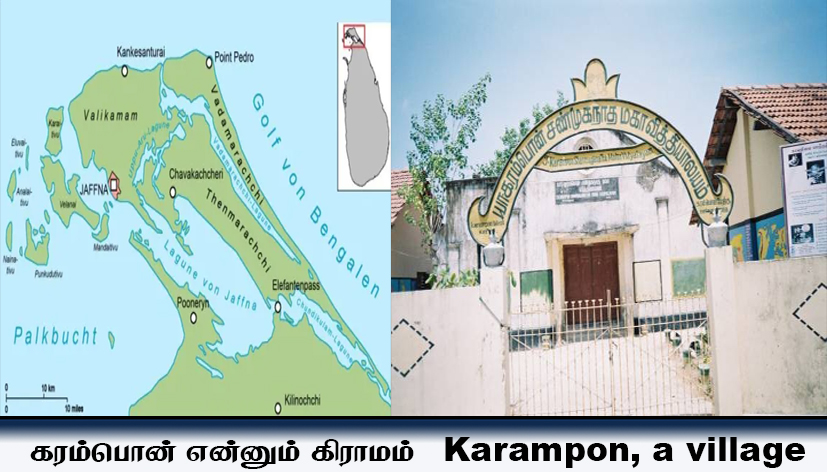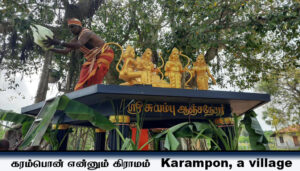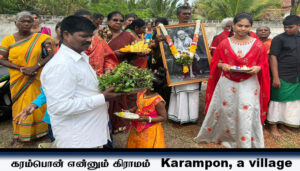

Karampon, a village on Velanai Island

Karampon In the southern section of the Jaffna District lies Karampon, a village on Velanai Island, was also names as Leyden by occupying Dutch in the 16th century. It is distinguished as the largest village among the seven Islands. A generally accepted theory on the name Karamban’s etymology traces back to its historical subjection to a chieftain called Kathiran, who served under the British Empire’s occupation. Originally named “Kadampan” to reflect the inhabitants of Muruga worshippers, the name gradually morphed into “Karamban,” and has recently been updated to “Karampon.” With a significant influx of pilgrims from the adjacent islands, the Indian subcontinent, and within Ceylon Island, Karampon has become a hub for monasteries that offer essential provisions and accommodation to these visitors.
 Subsequently, as these monasteries transitioned into temples, they continue to be recognized today as West matha and East matha. The monasteries once situated in the terraced fields have all been demolished, except for the Mangalavara Mutt, which persists as a vestige of history. Beginning in 1848, it has been providing services to traders from the Sri Lanka and the communities from the Indian subcontinent. Saiva and Christian worships are observed here, enriching the spiritual diversity of the area. A historic landmark, the Kannakiyamman temple, estimated to be two thousand years old, is a significant feature of the Karampon region. With its economy enriched by the cultivation of small crops and tobacco, alongside animal husbandry, Karampon has become notable for nurturing and producing several outstanding lithologists.
Subsequently, as these monasteries transitioned into temples, they continue to be recognized today as West matha and East matha. The monasteries once situated in the terraced fields have all been demolished, except for the Mangalavara Mutt, which persists as a vestige of history. Beginning in 1848, it has been providing services to traders from the Sri Lanka and the communities from the Indian subcontinent. Saiva and Christian worships are observed here, enriching the spiritual diversity of the area. A historic landmark, the Kannakiyamman temple, estimated to be two thousand years old, is a significant feature of the Karampon region. With its economy enriched by the cultivation of small crops and tobacco, alongside animal husbandry, Karampon has become notable for nurturing and producing several outstanding lithologists.
In 1951, during the process of blasting stones in this region, it led to an archaeological find in which a cache containing coins and a statue of Amman from the Raja Raja Chola I era was uncovered. Subsequently, with the Statue of Amman residing on location, the Thanthontry Manonmani Amman Temple, was constructed at that very site, where it remains an active place of worship to this day. During the times of the Liberation Eelam War, when military forces took control over the island, the community of Karampon was compelled to migrate and scatter across the globe. Karampon has not only been the cradle for numerous liberation warriors and champions fighting for Tamil Eelam’s freedom but has also gifted the Eelam nation with a wealth of creators, scholars, and labourers, maintaining its venerable legacy.
 The distinguished roster of personalities from Karampon includes the revered Tamil scholar Thaninayagam Adigal; the multifaceted Alfred Thambia, known for his endeavors in business and politics; Basthiampillai Theokuppillai, the esteemed former Bishop of Jaffna; the dedicated politician V. Navaratnam; the popular radio voice S. Punniyamurthy; and the respected W. Anthony, also celebrated as Annaviar. Their diverse contributions to scholarship, entrepreneurship, governance, ecclesiastical affairs, media, and social leadership vividly illustrate the dynamic and rich heritage of Karampon, Tamil Eelam. Vaddakkachchi, Vinod
The distinguished roster of personalities from Karampon includes the revered Tamil scholar Thaninayagam Adigal; the multifaceted Alfred Thambia, known for his endeavors in business and politics; Basthiampillai Theokuppillai, the esteemed former Bishop of Jaffna; the dedicated politician V. Navaratnam; the popular radio voice S. Punniyamurthy; and the respected W. Anthony, also celebrated as Annaviar. Their diverse contributions to scholarship, entrepreneurship, governance, ecclesiastical affairs, media, and social leadership vividly illustrate the dynamic and rich heritage of Karampon, Tamil Eelam. Vaddakkachchi, Vinod